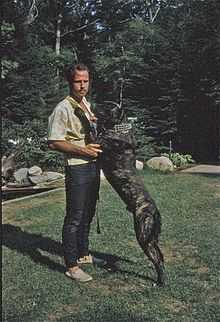Swinford Bandog
 | |||||||
| Country of origin | | ||||||
|---|---|---|---|---|---|---|---|
| |||||||
| |||||||
| Notes | Recognized by American Sentinel K9 Association | ||||||
| Dog (Canis lupus familiaris) | |||||||
The Swinford Bandog is an unrecognized type of guard dog. Developed by Dr. John Swinford, it is known because of Swinford's technique of selecting dogs based on performance rather than other traits.
History
The name Bandog has been around for many centuries, referring to a type of guard dog; however, the popularity of the bandog name was revived in the mid 1960s by veterinarian John B. Swinford. Dr. Swinford selected quality specimens from specific foundation breeds to create what he considered to be the ultimate guard dog, which he referred to as the Swinford Bandog (or Swinford Bandogge). Using performance selection, Dr. Swinford utilized selective breeding to produce what he believed was finest guard dog in existence. Swinford worked on his program for several generations, and came to receive significant recognition for his work in various books [1] and journals.,[2] but unfortunately Dr. Swinford died in November 1971 before solidifying the future of his creation.[3] For this reason, the long term success of his program has been questioned, but despite this his work played a significant influential role in re-igniting interest by some individuals and as a result there has been a resurrection of the Bandog name. Unfortunately, there is typically little or nothing in common between the modern Bandog programs and Dr. Swinford's program other than the "Bandog" name itself.
No breeding program today has dogs bred down from his program. The Swinford Bandog breed became rather notable during his lifetime as well as for some time after his passing, and has been referred to in many publications considering its limited lifespan, many of which were printed several decades ago. Such publications have included "The World of Fighting dogs by Carl Semencic"[1] ; The Working American Bulldog by Dave Putnam [4] ; Gladiator Dogs by Carl Semencic[5] ; the July-Aug issue of The Sporting Dog Journal (actually making one of the main articles as well as the cover story) [2] in "30 Years of Journal Cover Dogs by Jack Kelly ; Dog Catalog and vet journal dog catalog , and also in a few others[1][3] Swinford was described to have used performance selection to improve the functional capabilities and health of working dogs,[1][3] as working breeds have been shown to display general fitness and health from working lines of dogs is superior to non-working breeds.[6]
Dr. Swinford's vision developed somewhat from seeing the traditional working breeds dogs suffer from poor selection due to show breeders placing cosmetic appearance over the functional aspects of breeds. To awaken these lost abilities and to improve the effectiveness of the modern protection Mastiff type dogs, Swinford desired to recreate the working Mastiff dog by once again selecting on performance over all other criteria as had been done for centuries before.[3] By using performance measures, Swinford required his dogs to be completely safe, trustworthy, and stable within their home environment, yet also fear nothing when a protective situation deemed necessary. For this reason, Swinford selected game dogs such as the American Pit Bull Terrier to play a major role in awakening the functional working mastiff type dogs by improving their stamina, drive, athletic ability, confidence, and overall health.[1][3]

The Foundation Breeds
By using performance selection, John carefully selected various types of sound, protective mastiffs - primarily the English Mastiff - and bred them to performance-proven American Pit Bull Terriers to produce the original Swinford Bandogs. Bantu, the dog pictured with John (above) was a first generation Swinford Bandog produced in the 1960s from the breeding of a proven Bull and terrier stud (Kelly's "Bobtail Buddy" 2xW, not pictured)[2] to an English Mastiff bitch known as "Octavia".

Despite Dr. Swinford dying before finalizing the breed, there was enough interest in his dogs to maintain the program for several generations and into the next decade before finally disappearing entirely. The English Mastiff remained the primary mastiff component of the Swinford breed; however, in successive years other Mastiff types such as the Neapolitan Mastiff, Great Dane, and Tosa Inu were infused into the Swinford Bandog by some of the partners of Dr. Swinford's program.
Future
Most Bandog programs have essentially nothing in common with the original Swinford program; however, there are a few programs in existence today that have used Swinford's selection and breeding philosophy as a model to re-create John Swinford's work.
References
- ↑ 1.0 1.1 1.2 1.3 1.4 Semencic, Carl (1984). The World of Fighting Dogs. Neptune City, NJ 07753: T.F.H. Publications, INC. pp. 86, 208–219, 278. ISBN 0-86622-656-7.
- ↑ 2.0 2.1 2.2 Kelly, Jack (July–August 1972). "The Late Dr. John Swinford and One of His Bandogs". The Sporting Dog Journal: Cover story, 10, 13.
- ↑ 3.0 3.1 3.2 3.3 3.4 Robinson, H. Lee, Chimera Kennels. "Origin of the Swinford Bandog". Trainer/Breeder, Master of Sciences degree from the Department of Animal Sciences, U of Ill.
- ↑ Putnam, Dave (1999). The Working American Bulldog by Dave Putnam. Woodside, California 94062: Bulldog Press. pp. 17–18. ISBN 0-9672710-0-2.
- ↑ Semencic, Carl. Gladiator Dogs. Neptune City, NJ 07753: TFH Publications, Inc. pp. 176–183. ISBN 0-7938-0596-1.
- ↑ http://www.offa.org/stats_hip.html